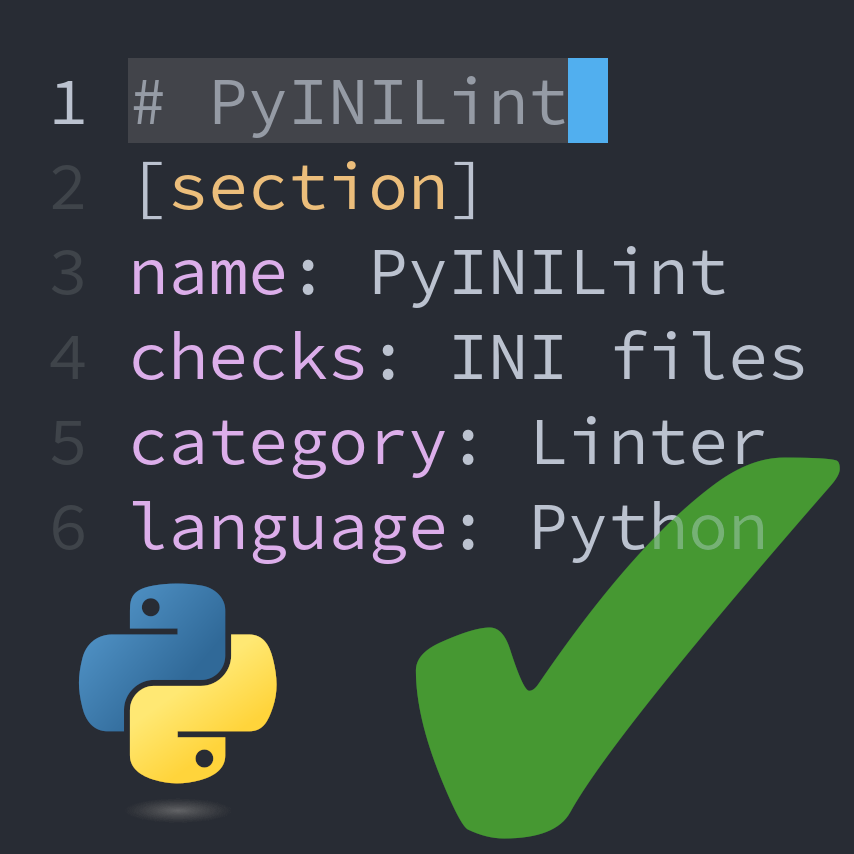A linter and inspector for INI format files
Project description
 PyINILint
PyINILint
The pyinilint command line utility allows you to lint (check the
syntax) of INI-like
configuration files. Here’s an example of the simplest possible
useage.
pyinilint myfile.ini
Silent output, and a 0 exit status means that myfile.ini has been
parsed successfully.
The pyinilint utility is a front-end to the Python
configparser
module, which supports interpolation. This means you can have
"variables" in your INI-files which can be optionally replaced with
values, which can be defined within the same, or different,
INI-file. Using different pyinilint command line switches you can
inspect what is happening with variable interpolation in your INI-files.
Installation
Copr
If you use Fedora then you can install pyinilint via a Copr
respository.
dnf copr enable danieljrmay/pyinilint
dnf install pyinilint
The installed RPMs include a man page and Bash completion script.
PyPI
You can get a distribution of pyinilint from
PyPI.
pip install pyinilint
However, this distribution currently does not include the man page or Bash completion script.
Source Code Release
You can download a source code release from the pyinilint project’s
GitLab releases
page. You can then install with something like the following:
tar -xzf pyinilint-0.10.tar.gz
cd pyinilint-0.10
make
make pybuild
sudo make install
sudo make pyinstall
The make and sudo make install builds and installs the man page
and Bash completion script. The make pybuild and sudo make pyinstall builds and installs the Python module and console script.
Usage
pyinilint --help
usage: pyinilint [-h] [-b] [-d] [-e ENCODING] [-m] [-o] [-r] [-s] [-v]
paths [paths ...]
pyinilint (version 0.10) is a linter and inspector for INI format files.
positional arguments:
paths paths of the file(s) to check
optional arguments:
-h, --help show this help message and exit
-b, --basic use basic interpolation, the default is extended
-d, --debug show debugging messages
-e ENCODING, --encoding ENCODING
set the encoding to be used, omit to use the default
-i, --interpolate interpolate the parsed configuration without output
-m, --merge merge files into a single configuration
-o, --output output the parsed configuration to stdout
-r, --raw output raw, do not interpolate
-s, --serialize output the interpolated and serialized configuration
to stdout
-v, --verbose show verbose messages
See https://github.com/danieljrmay/pyinilint for more information.
Options
-b, --basic
Use basic interpolation when parsing. See the Python configparser interpolation documentation below for more information.
-d, --debug
Output debugging messages, probably only of interest to those developing pyinilint.
-e ENCODING, --encoding ENCODING
Specifiy a non-default encoding to use when parsing the files to be checked.
h, --help
Display help and version information.
i, --interpolate
Interpolate the parsed configuration but do not output anything. This is useful for detecting warnings and errors in the interpolation syntax or values.
-m, --merge
Read all the specified files into a single Python ConfigParser
object; this allows interpolation between files. When this option is
not specified each file is read into its own seperate ConfigParser
object.
-o, --output
Output the parsed configuration to STDOUT without any
interpolation. Use the --serialize options to enable interpolation.
-r, --raw
Use raw mode, so there is no interpolation when parsing. See the Python configparser interpolation documentation below for more information.
-s, --serialize
Output the parsed, interpolated and serialized configuration to
STDOUT. Use this together with the --basic, --merge and --raw
options to inspect the interpolation of "variables" within you
INI-files.
-v, --verbose
Print verbose messages.
Exit status
This is the list of exit status codes and their meanings returned to
the shell by pyinilint.
| Exit Status | Name | Meaning |
|---|---|---|
| 0 | EXIT_OK | Everything went well, all files linted successfully. |
| 1 | EXIT_NON_EXISTANT_FILE | At least one of the specified files does not exist. |
| 2 | EXIT_SYNTAX_ERROR | There was an error in the command line syntax. |
| 3 | EXIT_UNREADABLE_FILE | At least one of the specified files existed but was not readable. |
| 4 | EXIT_DUPLICATE_SECTION | There is a duplicate section in the INI file. |
| 5 | EXIT_DUPLICATE_OPTION | There is a duplicate option in the INI file. |
| 6 | EXIT_INTERPOLATION_MISSING_OPTION | There is no corresponding option to a given interpolation key in the configuration. |
| 7 | EXIT_INTERPOLATION_DEPTH | Maximum recursion depth has been exceeded in interpolation. |
| 8 | EXIT_MISSING_SECTION_HEADER | There is a missing section header. |
| 9 | EXIT_PARSING_ERROR | Usually some kind of syntax error within an INI file. |
| 10 | EXIT_UNKNOWN_ERROR | A catch-all for some other kind of error, inspect the error message for more details. |
Examples
Check a single file
pyinilint myfile.ini
A silent response (with exit status of 0) means that myfile.ini has
passed the lint check.
Check multiple individual files
pyinilint -v myfile1.ini myfile2.ini
Check multiple files treating each one individually and output verbose messages.
Check multiple files in a collection, and output the serialized results
pyinilint -m -s myfile1.ini myfile2.ini
Check multiple files as part of a single ConfigParser object,
and output the parsed and interpolated values.
Check a file with a custom encoding
pyinilint -e iso8859_15 myfile.ini
Check myfile.ini using iso8859_15 encoding.
Caution
If your INI-files are ultimatly going to be parsed by an INI-parser
different from ConfigParser then you should be aware that there can
be subtle differences in INI-file format between parsers. However, it
should still spot most howling errors!
Contact
Please get in contact via the pyinilint project’s GitLab
website to:
- Report issues or make feature requests.
- Clone or fork the Git source code tree.
- Say “hello!” 😉
References
Project details
Download files
Download the file for your platform. If you're not sure which to choose, learn more about installing packages.














